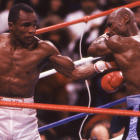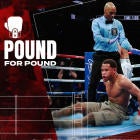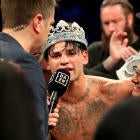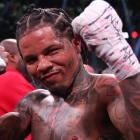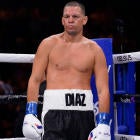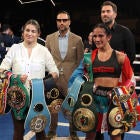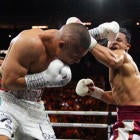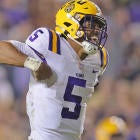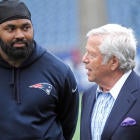When Sugar Ray Leonard looks back on one of the most important and memorable fights in boxing history, one that has been chronicled and rehashed from every possible angle, the Hall of Famer has one great reveal to share.
Thirty years ago to the day, Leonad snapped a three-year retirement due to a detached retina and, at age 30, moved up two weight classes (without a tune-up fight) to face legendary middleweight champion ‘Marvelous’ Marvin Hagler. The result was one of the most contentious scoring debates to date as Leonard pulled the upset at Caesar’s Palace in Las Vegas.
“I know something that I’m sure you guys are not privy to and that is that I was so fricking scared,” Leonard said, in an Instagram video on Thursday. “As I walked towards that ring and then when I got to the ring, I’m moving around and looking confident and what have you, but inside my head and inside my heart, there was still a little doubt.
“Not that much but it speaks volumes, it speaks heavy.”
Leonard, 60, who had fought just once in the previous five years before that night in 1987, wasn’t the only one who was fearful for his safety against Hagler, the rugged and reigning champion who had authored 12 title defenses. Former play-by-play announcer Tim Ryan, who called the fight for CBS, remembers that fear being the catalyst for the fight’s incredible build which captured the attention of the world.
“People were saying, ‘He was out of action for three full years and, my God, he has an eye injury that could turn him blind,’” Ryan told CBS Sports. “There was a whole lot of drama attached to that element of it.”
Ryan, who recently published a memoir titled “On Someone Else’s Nickel: A Life in Television, Sports and Travel” looking back on his 50 years in broadcasting, remembers Muhammad Ali-Joe Frazier I in 1971, which he called for New Zealand radio, as the biggest promotion for a fight he had ever experienced. But he considers Leonard-Hagler a close second.
Ryan hosted an hour long preview special on CBS the day before the fight, something he calls “unheard of at the time,” featuring an all-star panel including Thomas Hearns and John Madden.
“There were two things: One, Sugar Ray Leonard had already become one of the most popular champions ever,” Ryan said. “He was a handsome, good-looking guy, he was cocky and he was spectacular in the ring. He adopted his nickname from the great Sugar Ray Robinson and he had won an Olympic gold medal. He was an international sports star, not just a boxing star, that was part one.”
The second part of what made the build so dramatic, Ryan recalls, is just how due the blue-collar Hagler had been for an opportunity of this magnitude, after building a reputation as one of the greatest middleweight champions in history. Hagler, 32, had chased Leonard incessantly for years but was equally led on and avoided.
“Ray Leonard saw what very few people saw -- that Marvin was aging,” promoter Bob Arum of Top Rank said. “He was slowing up and Ray, even though he was retired, felt he could come back and take on Hagler. When he announced that he was coming out of retirement, people were incredulous.
“Hagler went off as a 6:1 or 7:1 favorite in the fight because Leonard was retired and Hagler was this dominant champion. Nobody gave Leonard a chance.”
Arum described the sporting culture as “mesmerized” ahead the fight, which instantly sold out Caesar’s Palace and closed circuit locations, along reaching fans in various parts of the country inside their living rooms through the growing platform of pay-per-view. But as Leonard remembers, any fear he had coming into the fight disappeared once he connected with the first punch.
“It wasn’t until the bell rung and all of a sudden I jabbed him and I hit him at will,” Leonard said. “I said, ‘This still works.’ And that’s when I knew that I had a chance to win.”
Hagler, a southpaw, surprised Leonard by boxing orthodox in the first two rounds, a strategy which Ryan remembers his late partner on commentary, Hall of Fame trainer Gil Clancy, astutely stating that Hagler had thrown away the early rounds with.
From there, both fighters took turns controlling the fight for three to four-round blocks, with Leonard finding his second wind late to finish each round with a 30-second flurry, which Arum believes was a strategy he modeled after Ali. Both Leonard and Ali shared the same trainer in Angelo Dundee.
“Very often, in close rounds, particularly in the [Ken] Norton fight, [Ali] would flurry at the end so that the impression he left in the judges’ minds was that he won the round,” Arum said. “Obviously rounds should be scored for the full three minutes but there is no questions that human beings being human will give more credit for the last part of a round.”
In the end, scorecards were mostly split between fighters. Ryan favored the plodding and consistently aggressive style of Hagler. He remembers Clancy favoring Leonard by a single round.
“The drama was the way the fight unfolded, with the ebb and flow to it and Ray finishing so strong,” Ryan said. “How is it possible this guy had one serious fight in five years -- and it wasn’t that serious -- and he looks like he’s fresh as a daisy? It was remarkable.”
In the end, however, the only one who didn’t have the fight close was judge Jose Juan Guerra of Mexico, who scored the 12-round bout 118-110 for Leonard, lifting him to a split-decision victory.
“[That was] just about the worst [scorecard], that was ridiculous,” Arum said. “The other two scorecards, those of [Dave] Moretti and [Lou] Filippo [who scored it 115-113 for either fighter], they were in the realm, the reasonable realm. But Marvin got cheated because they had that Mexican judge who was rumored to be connected to the [sanctioning] organizations which favored Leonard.”
Ryan, who interviewed both fighters in the ring immediately after the decision was read, remembers the look of resignation he saw in the fighters face as Hagler told him, “I beat him, I beat him. He knows it and everybody knows it.” The moment made Ryan instantly think back to the buildup of the fight, when Hagler worried publicly if he would get a fair shake.
“Marvin thought that he had enough points to win the fight,” Ryan said. “But Marvin thought coming in he was going to knock Ray out. He really believed that. So there was that stunned look on his face -- not just disappointment but kind of surprise.”
Leonard and Ryan, who were friends, did not speak much during the initial craziness after the fight. But Leonard, upon hearing Ryan had scored it for Hagler, reached out to him the following morning. Hours later, CBS arranged for a private screening of the fight for Leonard, Ryan and Clancy, as Leonard’s manager Mike Trainer lingered in the background.
“You could tell that Ray had wanted to reassure himself and show me that he had actually won the fight because he knew it was close,” Ryan said. “I told him that I scored it close for Marvin and Gil scored it close for you. Each round he would say, ‘Well, I won that round,’ and he would explain why and we did this for all 12 rounds. At the end, we’re all laughing and embracing each other. He was a great guy and a great friend.”
In the end, there would never be a second fight as Hagler defiantly retired and eventually moved to Italy, where he dabbled in acting while Leonard continued fighting to varied success amid multiple comeback attempts.
Arum remembers attending a dinner at Caesars in 1988 that honored both fighters where immediate talk of a rematch was put to bed for good.
“Ray called me over and said ‘Bob, go speak to [Hagler] and say let’s do the rematch, it will do a fortune of business,’” Arum said. “So I went over and talked to Marvin and said ‘Ray wants me to talk to you about a rematch.’ And Marvin looked at me with that scowl and said, ‘Tell that guy to get a life.’
“That was it -- we tried. Marvin was having no more of that.”












